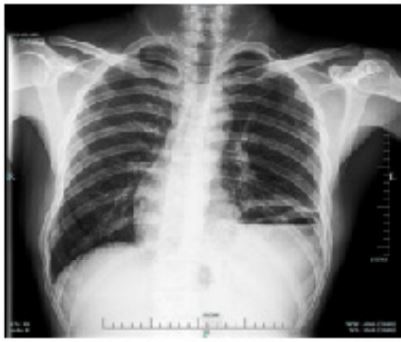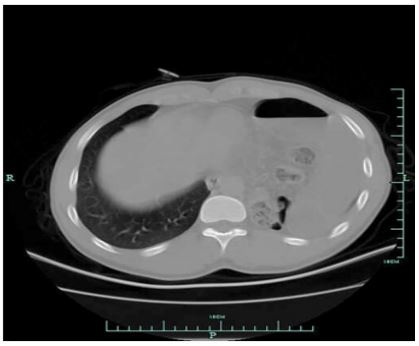Case Report - Volume 2 - Issue 5
Incarcerated Small Bowel inside A Slide Hernia Composed of Colon Wall Triggered by Left Bochdalek Hernia in Adult:An Extremely Rare Etiology of Acute Intestinal Volvulus
Jia-Cheng Li 1; Qi-Jun Yang2; Zhong Jia2*
1The Fouth Affiliated School of Clinical Medicine, Zhejiang Chinese Medical University, Hangzhou 310053, China.
2Department of Hepatobiliary Surgery, Affiliated Hangzhou First People’s Hospital, Zhejiang University School of Medicine, Hangzhou 310006, China.
Received Date : Aug 29, 2022
Accepted Date : Oct 06, 2022
Published Date: Oct 20, 2022
Copyright:© Jia Zhong 2022
*Corresponding Author : Jia Zhong, Huansha Road 261, Hangzhou 310006, Department of Hepatobiliary Surgery,Hangzhou First People’s Hospital, Zhejiang Province, P.R. China.Tel: +86-15988485261
Email: jiazhong664181@163.com
DOI: Doi.org/10.55920/2771-019X/1269
Abstract
Acute abdomen triggered by acute bowel obstruction is common in clinical practice, which may be caused by various reasons such as inflammation, tumors, intussusception and incarcerated hernia,etc. Here by, we describe a young man who was a heavy phsical worker presented with an abdominal pain and a sudden onset for nearly a day duration, accompanied with frequent nausea and vomiting, which could be partially relieved on his standing position. Empty feeling with mild tenderness was palpable on his right lower quadrant abdomen and abnormal bowel sounds were heard in his left chest cavity. Acute abdominal intestinal incarcerated obstruction was demonstrated on computed tomography (CT) of the abdomen. Urgent laparascopic exploration unveiled a Bochdalek hernia with a 3 cm defect in diameter that was subsequently closed by continual suture after the incarcerated reduced. The key to success is early identification of characterized features on images such as chest X-ray and abdominal CT, combined with the abdominal pain attack relieved by standing or semi-recombent position. In addition, the defect of Bodalek hernia is recommended to take a continual suture with a slowly absorbed barbed suture so as to strenthen the firmeness of the diaphragm.
Keywords: Acute abdomen; Bochdalek hernia; Diagnosis; Intestinal obstruction;Surgery.
Introduction
Acute abdomen in adults is very common in clinical practice, which may be resulted from various reasons. Among them, intestinal obstruction triggered by incarcerated hernia with 6~8 hours duration or beyond often leads to irrevisible intestinal necrosis, even life-threatening risk, requiring an urgent surgery. [1,2] For this reason, the optimum option is laparoscopic exploration rather than dangerous“waiting to see”or spending plenty of time on addressing the true culprit, especially for those uncommon internal hernias. [3,4,5] Nonetheless, efforts to making early diagnosis through identification of its specific details and characterized features on images is favorable to avoid potential of disastrous consequence. We here by report an uncommon incarcerated Bochdalek hernia in a young adult resulting in acute abdomen, aiming to share our experience.
Case History
A 27-year-old male presented with acute abdominal pain in the right lower quadrantof the abdomen for nearly 24 hours duration, accompanied with frequent nausea and vomiting. He didn't dare to eat anything or lie on a supine position in case of aggravating abdominal pain. For this reason, he had to keep a passive position such as semi-recombent or standing position to relieve symptoms, which was significantly different from other common acute abdomen. Despite of a high-risk job as a heavy physical worker, he never experienced abdominal trauma or surgery. Back to reviewing his past medical records, he had three times of similar abdominal pain attacks that were soon cured by conservative treatment last year. Under physical examination, empty feeling and mild tenderness on the right lower quadrant of the abdomen were palpable. Additionally, hyperactive bowel sounds were heard on the left lower chest. Laboratory testing showed a high inflammatory markers (e.g. increased neutrophil ( accounting for 83%, normal range: 40~75%)). Chest X-ray showed compression of the total left lung, broadened gas-fluid flat shadow of a segment of the intestine located in the left lower chest cavity, a right moving heart and an unidentified left diaphragm. (Figure 1) CT of the thoracic abdomen revealed a segment of small intestine combined with its mesentary herniated into the thoracic cavity, accompanied with torsion of its root vessels. (Figure 2) Therefore, urgent laparoscopic exploration was performed. During surgery, an incarcerated slide hernia was confirmed because a segment of transverscolonic mesentary adhesed at the perihernia ring (approximately 3 cm in diameter) as a part of the hernia sac and the incarcerated small intestine became the content of the slide hernia. In here, we described the special sirtuation as a hernia intussusception. Then, the defect of the left diaphragm was closed by continual suture using a slowly absorbed suture after the transverscolonic mesentery and the small intestine reduced. After surgery, a mediate volume of reactive ascites occured in the left chest cavity and was timely cured by ultrasound-guided minimally invasive interventional drainage combined with administrathon of antibiotics. Re-evaluation of chest CT demonstrated an inflated left lung. The patient was ultimately discharged on postoperative day 9. On an over 2-year outpatient follow-up, no evidence of hernia relapse or surgery-related complication was found.

Figure 1: Chest X-ray showing a broadened gas-fluid flat shadow of intestine occupying the left chest cavity, regional thickening pleura, unclear hemidiaphragm,right moving heart and the compressed lung.

Figure 2: CT of the thoraticoabdomen showing a segment of intestine and its torsional mesentery herniated into the left throacic cavity.
Discussion
Bochdalek hernia refers to a weak point or defect existed in the thoracicoabdominal conjunction of the diaphragm due to congenital factor (accounting for the great majority and mostly seen in children) or traumatic cause (accounting for the rest and extremely rare in adults) [6]. It was first described by Bochdalek in 1848 [7]. Acute abdomen caused by Bochdalek hernia is exceedingly rare in adults.
In this case, preoperative diagnosis relied on these characterized features below: A. Abdominal pain relieved by semi-recombent or standing position; B. Empty feeling on regional abdominal finger examination and abnormal bowel sounds on chest auscultation; C.images such as chest X-ray and CT showing a broadened gas-fluid flat shadow of intestine located in the thoracic cavity accompanied with compression of adjacent organs. The reason why the incarcerated small intestine for nearly a day duration didn't result in intestinal necrosis was thought to be associated with the special condition of Bochdalek hernia similar to“intussusception”based on a segment of colonic mesentary embracing another segment of small intestine, by which it' s not easy to lead to a tightly incarceration of small intestine.
As we all well know, the only curative treatment for Bochdalek hernia is herniaplasty by suture ( the defect less than 5 cm in diameter) or suture combined with artificial material (the defect up to 5 cm or beyond) [8]. The key to successful surgery in this case was to use a continual suture with a slowly absorbed barbed suture, aiming to strengthen the firmness of the suture since the diaphragm kept swiming.
Conclusions
Acute abdomen in adults could be caused by incarcerated Bochdalek hernia. The characterized feature of clinical manifestation and images were favorable to making early diagnosis. Continual suture with a slowly absorbed barbed suture for closing the defect was a successful experience to treat Bochdalek hernia.
Ethics statement: The imaging article was approved by the institutional review board at our hospital(Ethics Committee of Hangzhou First People's Hospital, China).
Consent statement: The patient has given his written informed consent for his data to be submitted or published.
Conflicts of Interest: All authors declare that they have no conflicts of interest concerning this manuscript.
Authors’ Contributions:
Postgraduate student Miss Fang Tian-Tian and Dr. Jiang Jin-Liang were involved in the compilation of the data and drafting of this manuscript. Dr.jia Zhong helped modify the manuscript-associated clinical data. All authors read and approved the final manuscript.
Funding: No
Acknowledgment: No
References
- Nilsson H, Nilsson E, Angeras U, Nordin P. Mortality after groin hernia surgery: delay of treatment and cause of death. Hernia. 2011 Jun; 15(3): 301-7. [PMID: 21267615 DOI: 10.1007/s10029-011-0782-4].
- Sá NC, Silva VCM, Carreiro PRL, Matos Filho AS, Lombardi IA. Rare case of incarcerated obturator hernia: Case report and review of literature. Int J Surg Case Rep. 2017;37:157-160. [PMID: 28686923; PMCID: PMC5499107 DOI: 10.1016/j.ijscr.2017.06.024].
- Fama' F, Galati M, Buccheri G, Palella J, Mento F, Gioffre'-Florio M. Laparoscopic repair of an incarcerated Bochdalek hernia in an elderly man.ANZ J Surg2017; 87(12): 1053-1054. PMID: 25943696.
- Thoman DS, Hui T, Phillips EH. Laparoscopic diaphragmatic hernia repair.Surg Endosc. 2002; 16(9): 1345-9. [DOI:10.1007/s00464-001-8162-2].
- Clifton MS, Wulkan ML. Congenital Diaphragmatic Hernia and Diaphragmatic Eventration. Clin Perinatol. 2017 Dec; 44(4): 773-779. [PMID: 29127959 DOI: 10.1016/j.clp.2017.08.011].
- Palanivelu C1, Rangarajan M, Rajapandian S, Amar V, Parthasarathi R. Laparoscopic repair of adult diaphragmatic hernias and eventration with primary sutured closure and prosthetic reinforcement: a retrospective study.Surg Endosc. 2009; 23(5): 978-985. [DOI: 10.1007/s00464-008-0294-1].
- Hu X, Liu B. Bochdalek hernia. Lancet (London, England).2018 07; 392(10141): 60. PMID: 30047400.
- Jambhekar A, Robinson S, Housman B, Nguyen J, Gu K, Nakhamiyayev V. Robotic repair of a right-sided Bochdalek hernia: a case report and literature review.J Robotic Surg 2018; 12(2): 351-355. PMID: 28500579.

